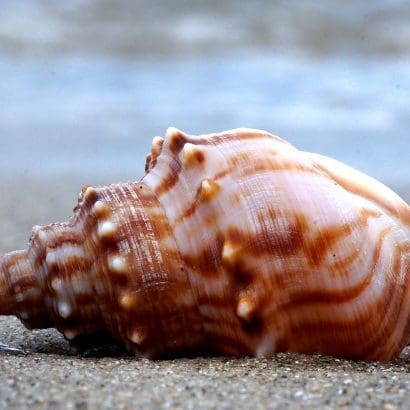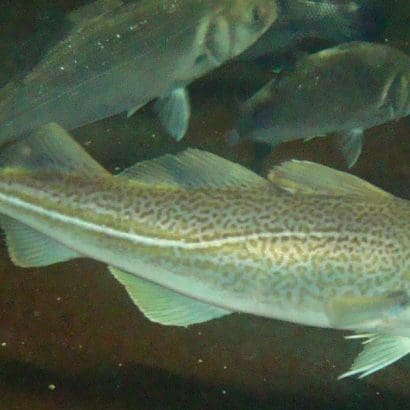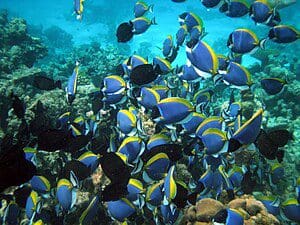
Fish schools, with their mesmerizing coordinated movements, have long captivated the curiosity of scientists and nature enthusiasts alike. The formation and synchronized movements of fish schools are fascinating phenomena that have intrigued researchers for years. Understanding how these intricate patterns emerge and how fish navigate through their watery world with such precision is a subject of ongoing scientific exploration. In this article, we will delve into the captivating world of fish schools, exploring the mechanisms behind their formation and the remarkable synchrony of their movements. Join us as we unravel the mysteries of these underwater spectacles and gain a deeper appreciation for the beauty and complexity of the natural world.
Contents
What is a fish school?.
A fish school refers to a large group of fish that swim together in a coordinated manner. These schools can vary in size, ranging from just a few individuals to thousands or even millions of fish. The formation of fish schools serves several purposes, including enhancing the survival and success of the individuals within the group.
Fish schools are comprised of various species of fish, including both freshwater and marine species. Some well-known examples of fish that form schools include herring, sardines, anchovies, and mackerel. These species often gather in massive aggregations, creating breathtaking displays of synchronized movement.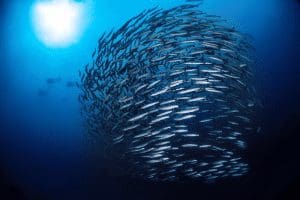
The primary function of fish schools is to provide protection against predators. By swimming together in tight formations, fish increase their chances of survival. The sheer number and density of the school can confuse and deter predators, making it difficult for them to single out an individual prey. Furthermore, the collective movements of the school can create a “safety in numbers” effect, reducing the likelihood of any one fish becoming a target.
In addition to predator avoidance, fish schools offer other benefits to their members. They facilitate more efficient foraging and feeding opportunities. By working collectively, fish can effectively locate and exploit food resources. This can be particularly advantageous when feeding on small prey items or during seasonal migrations.
Factors that influence the formation of fish schools.
The formation of fish schools is influenced by a variety of factors that can determine when and why fish come together to form these cohesive groups. Understanding these factors is key to unraveling the mechanisms behind the formation of fish schools. Here are some general factors that influence the formation of fish schools: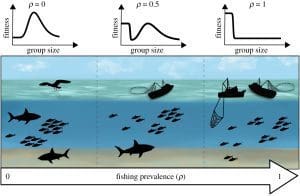
Predator Avoidance:
One of the primary drivers for fish to form schools is the need for protection against predators. By aggregating together, fish can confuse predators with their collective movements and make it harder for predators to single out individual prey.
Feeding Opportunities:
Fish schools often form around abundant food sources. When there is an abundance of prey, fish are more likely to gather together to take advantage of the feeding opportunities provided. Schools can efficiently locate and exploit food resources, increasing their chances of successful foraging.
Reproduction and Spawning:
Some fish species form schools during their reproductive cycles. These schools can serve as breeding grounds where individuals gather to release their gametes and increase the chances of successful fertilization.
Social Interaction:
Social behavior plays a significant role in the formation of fish schools. Some fish species are naturally inclined to form social groups and exhibit cooperative behavior. The presence of conspecifics (members of the same species) can attract other individuals, leading to the formation of larger schools.
Environmental Factors:
Environmental conditions, such as temperature, water currents, and availability of shelter, can influence the formation of fish schools. Certain environmental factors may create favorable conditions for fish to aggregate, such as areas with suitable water temperatures or locations with ample hiding spots.
Genetic Predisposition:
Genetic factors can also contribute to the formation of fish schools. Some species have innate genetic tendencies to form schools, passed down through generations. These genetic predispositions can influence the behavior and inclination of individuals to aggregate and form cohesive groups.
Communication and coordination in fish schools.
Communication and coordination are essential elements in the functioning of fish schools. The ability of individual fish to communicate with each other and coordinate their movements is what allows them to swim in synchrony and form cohesive groups. Here is some general information about communication and coordination in fish schools: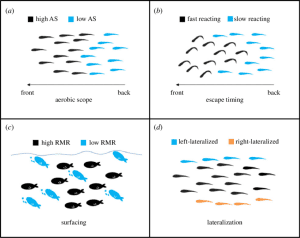
Visual Cues:
Visual communication plays a crucial role in fish schools. Fish rely on visual cues to align themselves with neighboring individuals and maintain proper spacing within the school. They observe the movements and body orientation of nearby fish and adjust their own behavior accordingly. These visual cues help them swim together in a coordinated manner.
Sensory Signals:
Fish also use sensory signals to communicate and coordinate within the school. They have specialized sensory systems, such as the lateral line system, which allows them to detect water movements and vibrations. By sensing the movements of their companions, fish can adjust their own swimming speed and direction to stay in sync with the group.
Chemical Communication:
Some fish species use chemical signals to communicate within the school. They release chemical substances, known as pheromones, into the water, which can convey important information to other individuals. These chemical signals can help coordinate behavior, such as foraging or reproductive activities, within the school.
Leadership and Followership:
Within a fish school, there may be individuals that exhibit leadership roles. These leaders set the pace and direction of movement for the rest of the group. Other fish in the school follow the lead of these individuals, creating a coordinated movement pattern. Leadership roles may shift within the school, allowing different individuals to take charge at different times.
Collective Decision-Making:
Fish schools can also exhibit collective decision-making processes. When faced with external stimuli, such as the presence of predators or changes in environmental conditions, the school as a whole may react and respond collectively. This coordinated response helps ensure the survival and well-being of the entire group.
Adaptability and Flexibility:
Fish schools demonstrate remarkable adaptability and flexibility in their communication and coordination. They can quickly adjust their movements in response to changes in the environment or the behavior of other individuals within the school. This flexibility allows them to maintain the cohesion and synchrony of the group.
Theories about synchronized movement.
The synchronized movement observed in fish schools has fascinated scientists for decades, leading to the development of several theories that attempt to explain this phenomenon. While the exact mechanisms behind synchronized movement are still the subject of ongoing research, here are some general theories that have been proposed: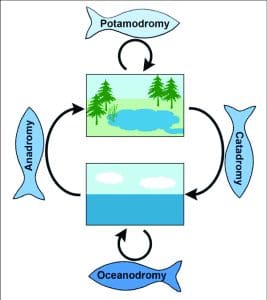
Self-Organization Theory:
According to this theory, fish schools exhibit emergent behavior through self-organization. Individual fish within the school respond to local interactions with their neighbors, resulting in collective patterns of movement. Through simple rules, such as maintaining a certain distance or aligning with nearby individuals, a complex coordinated behavior emerges at the group level.
Environmental Perception Theory:
This theory suggests that fish perceive and respond to environmental cues to achieve synchronized movement. Environmental factors, such as water currents, light gradients, or turbulence, can influence the behavior of individual fish within the school. By sensing and aligning their movements with these cues, fish can collectively synchronize their behavior.
Sensory Feedback Theory:
According to this theory, fish rely on sensory feedback to achieve synchronized movement. Each fish continuously adjusts its own movements based on the movements of its neighbors. Through sensory inputs, such as visual cues or water pressure changes, fish can perceive the actions of nearby individuals and make corresponding adjustments to maintain coordination.
Communication and Signaling Theory:
This theory suggests that fish communicate with each other through signals to achieve synchronized movement. Visual signals, such as body orientation or fin movements, can be used by fish to convey information about direction or speed. Chemical signals, such as pheromones, may also play a role in coordinating behavior within the school.
Leadership and Follower Theory:
Some theories propose that certain individuals within the fish school take on leadership roles, influencing the movement and behavior of the entire group. These leaders set the pace and direction, and other fish in the school follow their lead. This theory suggests that coordinated movement arises from a hierarchical structure within the school.
Scientific studies and technological advancements.
Scientific studies and technological advancements have significantly contributed to our understanding of fish schools and their synchronized movements. Researchers have employed various scientific methods and technologies to investigate the complex dynamics of fish schools, shedding light on the underlying mechanisms involved. Here is some general information about scientific studies and technological advancements in this field: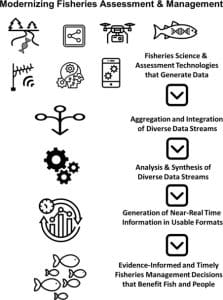
Field Observations:
Scientists have conducted extensive field observations to study fish schools in their natural habitats. These observations involve visually documenting the behavior of fish schools, noting their formation, movements, and coordination patterns. Field studies provide valuable insights into the real-life behavior of fish schools and help identify patterns and factors that influence their formation and synchronized movement.
Laboratory Experiments:
Researchers have conducted controlled laboratory experiments to gain a deeper understanding of the behavior and mechanisms involved in fish school formation and coordination. These experiments allow scientists to manipulate variables and observe how fish respond to changes in environmental conditions or social interactions. Laboratory studies provide a controlled environment to test hypotheses and uncover fundamental principles underlying fish school behavior.
Mathematical Modeling:
Mathematical models have been developed to simulate and predict the behavior of fish schools. These models integrate various factors, such as individual fish behavior, sensory perception, and environmental influences, to understand the collective behavior and movement patterns of fish schools. Mathematical modeling helps researchers explore different scenarios and test hypotheses about the mechanisms driving fish school dynamics.
Underwater Imaging and Tracking:
Technological advancements in underwater imaging and tracking systems have revolutionized the study of fish schools. High-resolution cameras, underwater drones, and sonar technology allow researchers to capture detailed visual data of fish schools in real-time. This technology enables precise tracking of individual fish within the school, providing valuable information about their movements and interactions.
Data Analysis and Machine Learning:
The increasing availability of large-scale data and advancements in data analysis techniques have facilitated in-depth studies of fish schools. Researchers use statistical analysis and machine learning algorithms to extract patterns and correlations from vast datasets, revealing hidden insights about the behavior and coordination mechanisms within fish schools.
Hydrodynamics and Fluid Dynamics:
Understanding the fluid dynamics of fish school movement has become an essential aspect of scientific studies. Computational fluid dynamics simulations and hydrodynamic analysis help researchers explore how water flow and pressure influence the movement and coordination of fish within a school. These studies provide a deeper understanding of the physical forces at play and their impact on fish school behavior.
Famous examples of fish schools.
Famous examples of fish schools showcase the remarkable collective behavior and mesmerizing synchronized movements exhibited by various species of fish. These examples have captivated the attention of researchers, nature enthusiasts, and filmmakers alike. Here is some general information about a few well-known and notable examples of fish schools:
Sardine Run:
The annual Sardine Run along the coast of South Africa is a breathtaking spectacle of fish school behavior. Millions of sardines form massive aggregations, creating a feeding frenzy for predators such as dolphins, sharks, and birds. This remarkable event attracts divers and wildlife enthusiasts from around the world who witness the dramatic movements and interactions of these vast fish schools.
Herring Schools:
Herring fish schools are famous for their tightly coordinated movements and shape-shifting formations. These schools can consist of thousands or even millions of herring, swirling and pulsating in unison. Herring schools are commonly observed in various regions, including the North Atlantic, Baltic Sea, and Pacific Northwest.
Anchovy Schools:
Anchovies are known for their remarkable schooling behavior. Large shoals of anchovies can form dense aggregations that can extend for several kilometers. These schools often attract predators such as dolphins, sea lions, and seabirds, creating a dynamic and visually stunning spectacle.
Mackerel Shoals:
Mackerel fish are known to form tightly packed and highly coordinated shoals. These shoals exhibit synchronized movements, creating shimmering patterns as they change direction and speed in perfect unison. Mackerel schools are common in both coastal and offshore waters and can be observed in various parts of the world.
Tuna Schools:
Tuna are powerful and fast-swimming fish that also exhibit schooling behavior. They often form large schools, known as “tuna balls,” where individual tuna swim together in tight groups. These schools are commonly observed during feeding frenzies when tuna gather to prey upon schooling fish such as sardines or anchovies.
Benefits of fish school formation.
The formation of fish schools offers a range of benefits for the individuals within the group and contributes to their overall survival and success. Fish schools provide a collective defense mechanism against predators, as swimming together in tight formations confuses predators and makes it difficult for them to single out an individual prey. The sheer number and density of the school create a “safety in numbers” effect, increasing the chances of survival for each fish.
Additionally, fish schools enhance foraging efficiency by collectively locating and exploiting food resources. Working together, fish can efficiently search for and capture prey, particularly when feeding on small organisms or during seasonal migrations. This improves the individual feeding success within the school.
Furthermore, some fish species form schools during their reproductive cycles. These aggregations serve as breeding grounds, where individuals gather to release their gametes and increase the chances of successful fertilization. The presence of a large school increases the probability of finding a suitable mate, enhancing reproductive success.
If you want to learn how fish generate their own light, click here.

